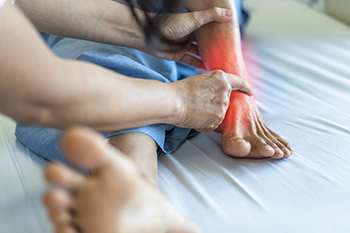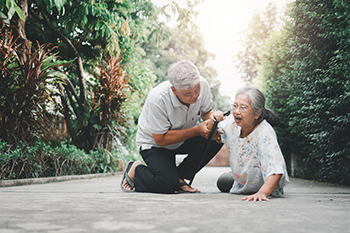Items filtered by date: July 2022
When the Tibial Nerve Becomes Compressed Within the Tarsal Tunnel

The tarsal tunnel is a narrow passageway in the ankle through which tendons, muscles, arteries and the tibial nerve travel. Any inflammation, growth, or other abnormality can cause this already narrow space to constrict further, causing the tibial nerve to become compressed. This compression may be caused by ganglion cysts or other masses within or outside the tarsal tunnel, diabetes, flat feet, injuries, or other sources of inflammation. Tarsal tunnel syndrome creates various types of symptoms including burning or shooting pains, numbness, electric shock and pins-and-needles sensations along the nerve’s path. Tarsal tunnel syndrome left untreated, may cause permanent nerve damage. That is why it is important to seek treatment immediately from a chiropodist if you experience any of the symptoms mentioned here.
Tarsal tunnel syndrome can cause pain and progress over time. If you are experiencing any symptoms of tarsal tunnel syndrome, please consult with one of the chiropodists from Complete Family Footcare & Therapy. Our clinicians will assess your condition and provide you with quality foot and ankle treatment.
What Is Tarsal Tunnel Syndrome?
Tarsal tunnel syndrome is a condition in which the posterior tibial nerve, which is located within a structure called the tarsal tunnel on the inside of the ankle, is squeezed. Compression of the posterior tibial nerve can be caused by injuries, such as ankle sprains, systemic diseases like diabetes or arthritis, strain on the tarsal tunnel due to flat feet, or an enlarged structure like a cyst squeezing the nerve.
Symptoms
Symptoms of tarsal tunnel syndrome can appear suddenly and are generally worsened by physical activity.
Common symptoms include:
-
Tingling, burning, or electrical shock sensation on the inside of the ankle or bottom of the foot
-
Numbness
-
Shooting pain
Diagnosis
Tarsal tunnel syndrome is diagnosed through physical examination. If initial treatment is ineffective, imaging or nerve studies may also be necessary.
Treatment
Nonsurgical treatments for tarsal tunnel syndrome include resting and icing the foot, bracing or immobilizing the foot, wearing an orthotic device, modifying your footwear, and taking medications to relieve pain. Surgery may be needed if nonsurgical treatments are ineffective.
If you have any questions, please feel free to contact our offices located in . We offer the newest diagnostic and treatment technologies for all your foot care needs.
Don’t Let Tennis Toe or Ankle Sprains Ruin Your Match

If you play tennis, you know that to be competitive, you need to be flexible and strong with lots of endurance. You also know that every part of your body is engaged while you are on the court. Legs, arms, elbows, knees, wrists, feet and ankles are hard at work, and at risk of being injured. Perhaps you have suffered an injury while playing tennis. You may have overly stretched the outer ligaments in one of your ankles. This is known as an ankle sprain, and is actually a very common tennis injury. Constantly stopping and changing direction during a tennis match can cause your toes to jam up against the front of your shoes. This is especially true if the shoe’s toe box is not roomy enough, or your toenails are too long. This type of injury, known as tennis toe, causes blood to collect underneath one or more toenail, making it turn black or red. A chiropodist can make professional suggestions regarding proper footwear and offer other preventative tips to help reduce your chances of further injury while playing tennis.
Injuries to the foot and ankle are very common among athletes. If you have experienced an injury, please consult with one of the chiropodists from Complete Family Footcare & Therapy. Our clinicians will assess your condition and provide you with quality foot and ankle treatment.
Common Injuries Among Athletes:
-
Achilles tendon injuries
-
Ankle strains or sprains
-
Plantar fasciitis
-
Fractures
-
Turf toe
-
Joint dislocations
-
Sever’s disease
-
Morton’s neuroma
Symptoms
Symptoms will depend on the cause and severity of the injury. Common symptoms for a foot or ankle injury include pain, swelling, tenderness, bruising, a reduced range of motion, and difficulty bearing weight or walking on the affected foot or ankle.
Diagnosis
Sports injuries are typically diagnosed after carefully examining the affected foot or ankle. This includes moving the injured area to test its range of motion. Medical history will need to be provided, as well as detailed information about how the injury occurred. Imaging studies, such as X-rays or MRIs, may be used to confirm or rule out certain diagnoses.
Treatment
Just like symptoms, treatment will depend on the type of injury and its severity. Initial treatment for many sports injuries is aimed at controlling inflammation and promoting the healing response. The acronym R.I.C.E is a helpful guide to implement for most acute injuries. This method involves resting, icing, compressing, and elevating the affected foot or ankle. In addition, anti-inflammatory medications may be administered and orthotic devices may be prescribed. For more severe injuries, surgery may be required. Lastly, rehabilitation or physical therapy may be needed to gain full functionality in the afflicted area.
If you have any questions, please feel free to contact our offices located in . We offer the newest diagnostic and treatment technologies for all your foot care needs.
Do You Suffer From Painful Feet?
Causes of Falls in Seniors

It is believed that about a third of seniors will experience a fall after the age of 65. Further, sore feet or flat feet are thought to be the most common causes. In addition, research shows that it is more likely that someone with foot problems is more prone to fall again. Taking certain medications may also contribute to the likelihood of a fall, as side effects can cause problems with balance and spatial awareness. Believe it or not, having a pet can contribute to a fall. Tripping over your pet or its toys can be responsible for losing your balance. Finally, refusal to follow safety suggestions in the home often causes falls. Here are a few ways to help prevent a fall and serious injury that may result. Wear sturdy shoes with non-skid soles that also offer adequate support. Use a walking aid if balance is a problem. Install grab bars in showers and tubs. Remove scatter rugs, clear hallways of clutter, and make sure to have adequate lighting. Finally, it is a good idea to consult a chiropodist regularly to monitor the health of your feet and ankles.
Falls are a common but preventable problem for older adults. If you would like to learn more about preventing falls, please consult with one of the chiropodists from Complete Family Footcare & Therapy. Our clinicians can help you maintain the health of your lower limbs and your mobility.
Did you know that most falls occur in the home? Fortunately, there are many simple changes that you can make to the living environment to reduce the risk of falling.
In the Bathroom:
-
Install grab bars near toilets, bathtubs, and showers
-
Put non-skid mats on all surfaces that may get wet
In the Bedroom:
-
Keep a light near the bed so that you can easily turn it on if you have to get up at night
-
Keep the path from your bedroom to the bathroom clutter-free and well-lit
-
Consider installing a bed rail for added support
In the Kitchen:
-
Use non-skid mats
-
Wipe up any spills immediately
-
Move commonly used items to areas that are easily within your reach
In the Hallways:
-
Place handrails on both sides of the stairs
-
Install good lighting in the hallways and around the entire home
-
Keep hallways free of clutter
-
Don’t use throw rugs or small area rugs
In Other Living Areas:
-
Keep loose cables, cords, and wires near the wall and away from walking surfaces
-
Make sure that all carpets and rugs are secure firmly to the floor
-
Arrange your furniture so that it is not in your way when you walk
-
Use chairs and couches that you can easily get up from
If you have any questions, please feel free to contact our offices located in . We offer the newest diagnostic and treatment technologies for all your foot care needs.

